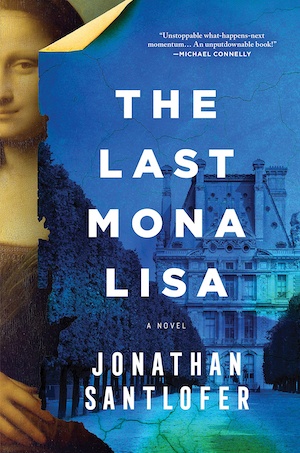
Art crimes are one of the more intriguing branches of international crime and in The Last Mona Lisa American author Jonathan Santlofer melds past and present to explore several motivations. His conceit begins with a real crime that took place in 1911. Fired from his job at the Louvre, Vincenzo Peruggia hid in the museum overnight and stole the Mona Lisa. The destitute Peruggia was an Italian patriot and wanted to return the painting to Italy, which he deemed its rightful home, and make a little money too, perhaps. The painting resurfaced two years later in Florence whereupon the Italian police arrested him.
Santlofer’s story features an American named Luke Perrone, great-grandson of Peruggia. Since childhood, Luke has researched his notorious ancestor, in particular whether he kept a diary during his months in prison. Luke is a frustrated painter and college history of art professor, and an upcoming school break gives him a chance to follow up on a new lead. He’s learned that his great-grandfather’s journal was donated to Florence’s Laurentian Library among the papers of a recently deceased art scholar.
Meanwhile, Interpol analyst John Washington Smith has the lingering suspicion that the painting in the Louvre may not be the original. During the Mona Lisa’s two-year disappearance several copies were made and sold as originals. Not all have been traced and debunked. Perhaps it was one of the copies that found its way back to the Louvre? Smith has been monitoring Luke’s electronic communications for years. He knows about the new lead. He knows about the trip to Florence. If that inquiry is finally showing promise, Smith’s career is not. He’s sure to be sacked if his uptight supervisor discovers his unauthorised investigation, so he is desperate for a success.
Art mysteries make such a refreshing change from from the drug dealers and serial killers we’re used to reading about. In The Last Mona Lisa you’ll find different types of characters who have more nuanced obsessions. While the huge sums involved attract criminals who are just as venal as any other malefactors, and in this story, several are just as dangerous but they operate in a different sphere of unscrupulousness.
Luke is an academic, and a bit slow to put it together that there are too many coincidences and too many people around him dying. You can blame his obliviousness partly on distraction. Another patron of the Laurentian Library, Alexandra Greene, has captured his attention. She’s researching plagues – and maybe that should be a warning sign! Luke believes she’s attracted to him too, but she runs so hot and cold he can’t be sure where he stands from one encounter to the next.
Luke does indeed find the diary in the dead professor’s papers, believes it to be authentic, and begins to read. Chapters about Luke, Alexandra and Smith in the present day are interspersed with Vincenzo’s own story. He describes what drove him to steal the Mona Lisa and what happened next, including the creation of the replicas. These atmospheric historical chapters give resonance to the quest of three main characters. Things could turn deadly at any moment as a stop-at-nothing collector is just as eager to find out whether ‘his’ Mona Lisa is the real thing.
Santlofer grounds the present-day of his tale with reference to the real-life controversy surrounding another Leonardo work, the Salvator Mundi, or ‘the male Mona Lisa.’ This painting was bought in 2005 from a New Orleans auction house for $1,175, and it sold 12 years later for $450,300,000, even though art experts disagree about its authenticity. Referring to this saga underscores not just the amazing sums involved, but also the tangled motivations of people in the world of stolen and fabricated art who are dealing with objects that are, essentially, priceless.
Santlofer, himself an artist of some note. As well as his award-winning mystery novels he has held more than 200 exhibitions worldwide. His short stories have appeared in numerous anthologies, and he was creator and director of the Center for Fiction’s Crime Fiction Academy. He resides in New York.
In 2012, he shared his thoughts with us about crime writing here. Another notable recent thriller involving art world shenanigans is SJ Rozan’s The Art of Violence.
Sourcebooks Landmark
Print
£12.74
CFL Rating: 4 Stars









